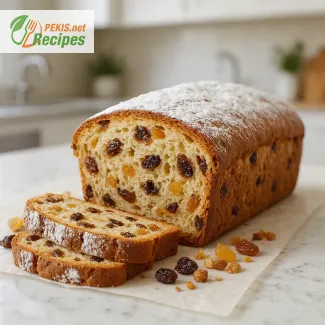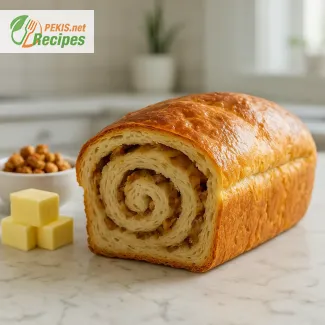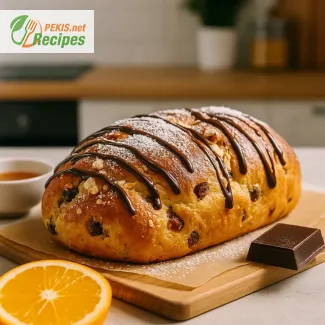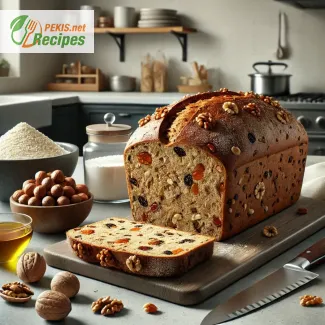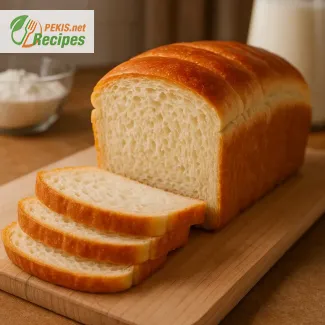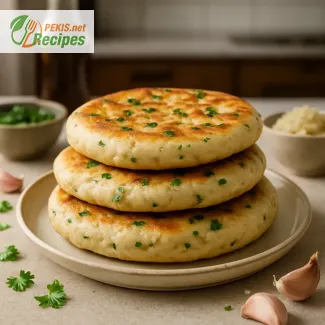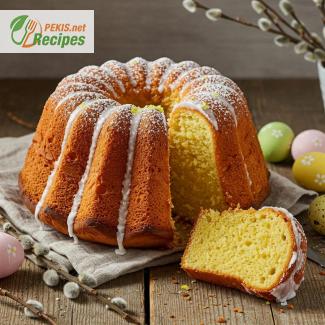
Authentic Polish Babka: A Timeless Easter Tradition
Discover the buttery, golden cake that symbolizes Polish holiday joy
There is something undeniably comforting about the scent of freshly baked Polish Easter Babka wafting through the house in early spring. With its soft, rich crumb and beautifully golden crust, this cake is more than just a dessert—it's a cherished symbol of Polish heritage and a culinary centerpiece of the Easter season. Whether served plain, glazed with a delicate icing, or dusted with powdered sugar, babka evokes both celebration and nostalgia, bringing generations together around the table.
Unlike many modern cakes that focus on decoration or novelty, Polish babka holds firm to its centuries-old tradition, prioritizing simplicity and flavor. The name babka, derived from the Polish word for "grandmother," hints at its homely charm and the tender care with which it is usually prepared. While regional variations exist, the classic Easter babka is known for its high, domed shape, created using a bundt or fluted pan, and for its decadent, buttery dough often enriched with egg yolks and a hint of citrus zest. This gives the cake a velvety texture that is both delicate and indulgent, perfect for enjoying after the Lenten fast.
During Easter, babka takes on a symbolic importance in Polish households. It is often included in the święconka—a traditional Easter basket brought to church for blessing on Holy Saturday, filled with foods that signify abundance and joy. Alongside sausage, eggs, and horseradish, babka represents the sweetness of life and the blessings of spring. For many families, baking babka is a sacred ritual passed down through generations, each step imbued with stories and shared moments in the kitchen.
What makes this cake truly special is its versatility and elegance. Some versions are infused with rum-soaked raisins, candied orange peel, or a swirl of chocolate or poppy seeds, while others remain pure and simple, focusing on the buttery richness of the dough itself. A thin glaze of lemon or vanilla icing, allowed to gently cascade over the sides, adds just the right amount of sweetness without overpowering the delicate flavors. And when it’s finally time to slice into the cake, the inside reveals a pillowy interior with a golden hue, a testament to the quality of ingredients and time invested in its creation.
The texture of a well-made babka is unmistakable—light yet dense, airy yet satisfying. It pairs beautifully with a cup of strong black tea or rich coffee, making it a fitting choice not only for the Easter table but also for a lazy spring morning or a cozy afternoon treat. It’s a cake that doesn’t demand attention through flashy toppings or excessive sweetness. Instead, it invites you to pause, enjoy, and connect with tradition.
Polish Easter babka also carries with it a certain celebratory elegance that makes it suitable for festive gatherings. Its stately appearance, with delicate folds created by the bundt mold, makes it look almost regal—yet its ingredients are humble and pantry-friendly. Butter, sugar, eggs, flour, and yeast are transformed through slow fermentation and gentle baking into a cake that feels both luxurious and deeply rooted in home cooking.
For those exploring Polish cuisine for the first time, babka offers an inviting introduction. It showcases the country's affinity for baking, its reliance on time-honored methods, and its passion for foods that feed both body and soul. Baking babka is also a lesson in patience and love—waiting for the dough to rise, shaping it with care, and finally watching it bloom into its golden form in the oven.
When served on Easter morning, often after Mass or as part of a celebratory brunch, babka becomes more than just a dish—it’s an embodiment of family, heritage, and the passage of time. And for many Polish families, no Easter would feel complete without it. This is a cake that continues to inspire pride, warmth, and connection—one buttery slice at a time.
In the modern kitchen, preparing a traditional babka is a way to slow down and embrace intentional baking, connecting with the rhythms of the season and the richness of cultural rituals. Whether you're continuing a family tradition or starting a new one, baking Polish Easter babka brings not only the joy of creation but also the deep satisfaction of honoring something bigger than ourselves: a heritage baked into every crumb.
Coming up next, you'll find a detailed recipe to make your own Polish Easter Babka cake at home—simple enough for beginners yet worthy of any Easter feast. Let the scent of citrus, vanilla, and butter fill your kitchen, and experience the magic of this beloved Polish treasure.
- Activate the yeast:
Warm the milk (not hot, about 35–40°C / 95–104°F) and stir in 1 tsp of sugar and the yeast. Let it sit for 10–15 minutes until frothy. - Prepare the dough base:
In a large mixing bowl, combine flour, the remaining sugar, salt, and lemon zest. In a separate bowl, lightly beat the egg yolks and whole eggs. Add the eggs, vanilla extract, and the activated yeast mixture into the flour mixture. - Knead the dough:
Start mixing the ingredients with a wooden spoon or mixer with dough hooks. Gradually add softened butter, kneading until the dough is smooth, elastic, and slightly shiny (about 10 minutes by mixer or 15 minutes by hand). If using raisins and/or candied orange peel, fold them in at the end. - First rise:
Cover the bowl with a clean towel and let the dough rise in a warm, draft-free area for about 60–75 minutes, or until it has doubled in size. - Shape the babka:
Butter a tall bundt or babka pan (around 2-liter capacity). Gently punch down the dough and transfer it into the prepared pan. Smooth the top and cover it again for the second rise (around 30 minutes), until the dough fills most of the pan. - Bake:
Preheat the oven to 170°C (340°F). Bake the babka for about 45–50 minutes, or until golden brown and a skewer inserted into the center comes out clean. If the top browns too quickly, cover it loosely with foil during the last 15 minutes. - Cool and finish:
Let the cake cool in the pan for 10 minutes, then turn it out onto a wire rack to cool completely. Optionally, dust with icing sugar or drizzle with a simple lemon glaze (mix 100 g icing sugar with 1–2 tbsp lemon juice).
Elevating the Traditional Polish Babka: Expert Techniques for Modern Bakers
Creative adjustments and thoughtful improvements to enrich your Easter baking
While the traditional Polish Easter babka holds an important place in cultural and culinary heritage, there are numerous ways to refine and modernize this beloved cake without compromising its nostalgic character. By making thoughtful ingredient substitutions, adjusting techniques, or infusing new flavors, home bakers can create a version that feels both familiar and exciting. Whether you aim for a more nutritious profile, deeper complexity in taste, or simply a more foolproof baking process, these expert tips will help you bring out the best in every slice.
Choose high-quality ingredients for a superior result
The first and most impactful improvement to any classic recipe begins with the quality of the ingredients. For babka, the flavor hinges on just a few core elements: flour, butter, eggs, sugar, and yeast. Opting for organic or locally-sourced eggs, European-style high-fat butter, and unbleached all-purpose flour will give your cake a richer, more authentic flavor. Using freshly grated lemon zest instead of bottled flavorings provides a bright citrus aroma that enhances the richness of the dough.
If you're using yeast, choose fresh baker’s yeast when possible—it provides a more consistent rise and a milder, cleaner taste compared to dried yeast. Allowing the dough to ferment slowly during the first rise (for example, letting it rise in the refrigerator overnight) also deepens the flavor and improves texture.
Flavor enhancements that respect tradition
While the classic babka is lightly scented with vanilla and lemon, adding a touch of almond extract, orange blossom water, or spiced rum can create a more sophisticated flavor profile. Incorporating cardamom or nutmeg in small quantities adds subtle warmth that pairs beautifully with the cake’s buttery base.
Another simple but effective upgrade is to brown the butter before incorporating it into the dough. This deepens the flavor and introduces delicate caramel and nutty notes, giving the cake an unexpectedly rich finish.
Incorporating healthier alternatives
For those seeking a slightly more nutritious version of babka, some substitutions can be made without drastically altering the experience. Try replacing part of the all-purpose flour with white whole wheat flour (up to 30%) to increase fiber content without compromising softness. You can also substitute refined sugar with coconut sugar or maple syrup, though this may result in a darker crumb and more caramelized flavor.
Greek yogurt or buttermilk can be used to replace part of the butter, contributing moisture and a slight tang while reducing saturated fat. However, these additions may also change the crumb texture slightly, making it softer and more cake-like.
Fillings and inclusions that enhance character
While raisins and candied citrus peel are traditional, they’re not the only possibilities. Upgrade your babka by swirling in dark chocolate, sweetened poppy seed paste, or cinnamon-sugar butter. For a more indulgent twist, create a marble effect using cocoa or Nutella-like spreads.
For those looking to incorporate fruit, dried cherries, cranberries, or finely chopped dates soaked in a flavored liquor or juice can provide a tender bite and enhance visual appeal. Always make sure to soak dried fruits beforehand to avoid a dry texture in the final product.
Glazing and finishing options that make an impression
The classic finish for babka is either a simple powdered sugar dusting or a lemon glaze. To elevate the presentation, consider using a mirror glaze, a vanilla bean icing, or even a thin layer of white chocolate ganache. These variations not only enhance the cake’s appearance but also introduce complementary flavors that amplify the cake’s subtle sweetness.
For a more rustic and festive finish, sprinkle slivered almonds, pearl sugar, or edible dried flower petals on top of the glaze before it sets. This not only adds texture but transforms the babka into a visually stunning centerpiece for your Easter table.
Why homemade Polish babka is always better
Store-bought versions often fall short due to preservatives, artificial flavors, and overly sweetened fillings. When made at home, babka retains a light, fresh texture, and you maintain full control over every element—from sweetness to texture to ingredient quality.
Homemade babka also allows for personalization, which is key in creating a dessert that resonates with your family’s preferences. Moreover, the ritual of baking—kneading the dough, watching it rise, and enjoying the aroma as it bakes—brings a level of emotional satisfaction and mindfulness that no store-bought cake can replicate.
Common mistakes and how to avoid them
One of the most frequent mistakes is under-kneading the dough, which leads to poor gluten development and a dense crumb. The dough should be elastic and smooth before the first rise.
Another issue is overproofing, which can cause the cake to collapse or bake unevenly. Keep an eye on the dough’s volume—it should roughly double in size but not exceed that. Using an oven thermometer is also key, as uneven baking temperatures can result in dry edges and an underbaked center.
Be cautious when adding inclusions like raisins or chocolate—too many can overwhelm the structure, making it harder for the cake to rise properly. A good rule is to limit mix-ins to no more than 20–25% of the total dough weight.
Make-ahead tips and storage advice
To better manage your time, prepare the dough the day before and let it rise slowly in the refrigerator overnight. This improves flavor and frees up your schedule on baking day. Once baked, babka keeps well at room temperature for up to 3 days when wrapped tightly.
To extend its shelf life, wrap slices individually and freeze them for up to one month. To reheat, place in a warm oven for a few minutes until refreshed.
Perfecting your babka
Improving a traditional recipe like Polish babka is less about drastic reinvention and more about refinement—selecting better ingredients, understanding baking science, and embracing personalization. With a few thoughtful tweaks, your Easter babka can transform from a nostalgic treat into a showstopping centerpiece that balances heritage with creativity.
By exploring these improvements, you'll not only master the art of Polish baking, but you'll also bring deeper meaning and joy to your Easter celebrations—one slice at a time.
- Eggs
- Milk
- Gluten (wheat)
How to make it allergen-free:
- Eggs: Replace each egg with 60 g (¼ cup) of unsweetened applesauce or use commercial egg replacers.
- Milk: Use plant-based milk such as almond or oat milk in the same quantity.
- Butter: Substitute with vegan butter or margarine.
- Gluten: Use a certified gluten-free flour blend designed for yeast baking and add 1 tsp xanthan gum.
- Vitamin A: 420 µg – Supports vision and immune function
- Vitamin B12: 0.5 µg – Essential for red blood cell formation
- Vitamin D: 0.6 µg – Aids calcium absorption and bone health
- Calcium: 40 mg – Maintains strong bones and teeth
- Iron: 1.1 mg – Supports oxygen transport in blood
- Magnesium: 18 mg – Important for muscle and nerve function
- Potassium: 95 mg – Helps regulate fluid balance
- Zinc: 0.6 mg – Strengthens immune system
- Beta-carotene: 190 µg – Supports skin and eye health
- Lutein and zeaxanthin: 110 µg – Protects eye tissues
- Flavonoids (from lemon zest): 0.8 mg – Anti-inflammatory and heart-protective
- Vitamin E: 0.7 mg – Protects cells from oxidative stress
